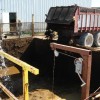 Anaerobic digestion of livestock manure is a microbe-mediated process carried out in vessels or tanks, where the livestock wastes are digested slowly in environment absent of oxygen. The main products are biogas, anaerobically digested liquid (ADL), and solid (ADS), which can be land-applied as an organic soil amendment or a source of plant nutrients. This 4-page fact sheet provides research-based information about using anaerobically digested beef-cattle manure as an organic source of nitrogen for supplementing crop nutrition in Florida sandy soils, including initial N concentration, application timing, rate of application, and method of application. Written by Rishi Prasad and George Hochmuth, and published by the UF Department of Soil and Water Science, April 2015. (Photo: George Hochmuth, UF/IFAS)
Anaerobic digestion of livestock manure is a microbe-mediated process carried out in vessels or tanks, where the livestock wastes are digested slowly in environment absent of oxygen. The main products are biogas, anaerobically digested liquid (ADL), and solid (ADS), which can be land-applied as an organic soil amendment or a source of plant nutrients. This 4-page fact sheet provides research-based information about using anaerobically digested beef-cattle manure as an organic source of nitrogen for supplementing crop nutrition in Florida sandy soils, including initial N concentration, application timing, rate of application, and method of application. Written by Rishi Prasad and George Hochmuth, and published by the UF Department of Soil and Water Science, April 2015. (Photo: George Hochmuth, UF/IFAS)
http://edis.ifas.ufl.edu/ss637
Tag: anaerobic digesters
Anaerobic Digesters for Manure Management for Livestock Operations
 Livestock wastes can be important sources of nutrients for crops, but manure must be managed properly to prevent loss of nutrients to the environment in air or ground and/or surface water. Stabilization of manure is important prior to successfully recycling the organic material back to arable lands. Methods for stabilizing livestock wastes include composting, aerobic digestion, anaerobic digestion, lime stabilization, and heat drying. The stabilization process reduces the organic matter and water contents, unpleasant odors, concentrations of pathogenic microorganisms, and weed seeds. Anaerobic digestion (AD), which is the topic of this fact sheet, also results in the production of renewable energy in the form of methane-rich biogas. This 10-page fact sheet informs farmers and Extension agents about types of anaerobic digester systems used in the United States with various manure-handling systems. It points out digester systems currently being used in Florida and the benefits of managing livestock manure with a digester system. Written by Rishi Prasad, George Hochmuth, and Ann C. Wilkie, and published by the UF Department of Soil and Water Science, March 2014.
Livestock wastes can be important sources of nutrients for crops, but manure must be managed properly to prevent loss of nutrients to the environment in air or ground and/or surface water. Stabilization of manure is important prior to successfully recycling the organic material back to arable lands. Methods for stabilizing livestock wastes include composting, aerobic digestion, anaerobic digestion, lime stabilization, and heat drying. The stabilization process reduces the organic matter and water contents, unpleasant odors, concentrations of pathogenic microorganisms, and weed seeds. Anaerobic digestion (AD), which is the topic of this fact sheet, also results in the production of renewable energy in the form of methane-rich biogas. This 10-page fact sheet informs farmers and Extension agents about types of anaerobic digester systems used in the United States with various manure-handling systems. It points out digester systems currently being used in Florida and the benefits of managing livestock manure with a digester system. Written by Rishi Prasad, George Hochmuth, and Ann C. Wilkie, and published by the UF Department of Soil and Water Science, March 2014.
http://edis.ifas.ufl.edu/ss615